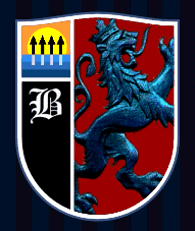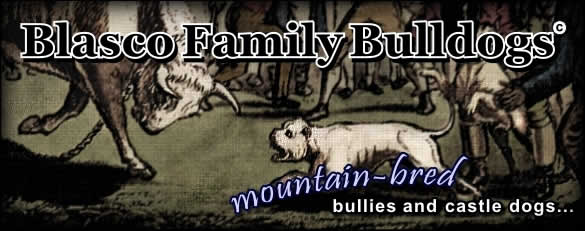

 |
 |
|
|
| Home | Dog Profiles | More Photos | Articles | Available | Policies & Procedures | FAQs | Contact |
|
|
American Bulldog
History
|
|
"History in the United States" (American Bulldog history) "The original bulldog was preserved by working class immigrants who brought their working dogs with them to the American South. Small farmers and ranchers used this all-around working dog for many tasks including farm guardians, stock dogs and catch dog. These dogs were not an actual breed as considered by today's standards but were a generic bulldog type. There were no recorded pedigrees or records and breeding decisions were dependent on the best working farm dogs despite breed or background. Several separate strains of the "bulldog" type dogs were kept by ranchers as utilitarian working dogs."
No doubt there are those who would argue or add to that history. Dog breeding is like that; brings out the cultural anthropologist in everyone - me too, but I don't think it matters that much and further, I think we make a mistake when we focus on the American Bulldog's American history, rather than the identity and histories of his progenitors. What interests me most is the American Bulldog's earlier, pre-American history, not only of the dog we now call the American Bulldog in his three primary types and multiple bloodlines, but also his cousins - maybe even brothers from long before... |
|
|
|
To the left, ancient Europeans refined large, white and dark colored breeds for the purpose of hunting. Pictured, one version of the now extinct Alaunt, descendant of Asiatic Masiffs bred to German Mastiffs and Bullenbeissers. "The Romans made use of steppe
nomads in their cavalry. Marcus Aurelius sent 5,500 Alans to Britian,
where they guarded Hadrian's Wall. Their fierce Alaunt dogs went with
them." The
Mastiffs, The Big Game Hunters |
 |
|
In the lower left corner, a progenitor of the American Bulldog, long before arriving in the New World and roughly the size of a man. |
|
"The author Marius Terentius Varro, who died in the year 27 B.C., reports in his book on agriculture of two kinds of dogs that were bred in this country (Rome). The first were hunting dogs and the second large herding dogs, who effectivly protect sheep and goats. From this description of these herding dogs we quote:
(Fighting Dog Breeds, Dr. Dieter Fleig, TFH Publications,
1996)
|
|
|
 |
|
|
 |
|
The white dog's master with the long spear is a hunter; notice the horn at his hip, the twine and loops on his arm and waist. In ancient times wolves, bears, lions, and the centuries famous and feared wild boar were hunted with such dogs. This is not a hunting party, however, not with the ladies in their finery. This is a garden party, the hunter and his dogs present to protect the nobles from wild beasts. Nothing can screw up a garden party faster than a wild boar! Take note also of the wide, metal "cut-collar," on the dog discussed. It is in fact similar to those used today on hog-dogs, protecting their throats from razor sharp tusks. It is the collar of a dog bred to go into battle, fearlessly confronting man and wild beast alike upon command. Some will say this dog is an early Greyhound, to which I reply, study your dog lore Sparky. At this point in history, Greyhounds, Mastiffs, Great Danes - all were the same stock. |
|
And centuries later in the New World, the same dogs with the same purpose remained... "In his History of Virginia,
first published in 1705, Robert Beverly ...says that the hunters always
took their "great dogs," their mastiffs and greyhounds, with
them on these excursions to guard against wolves, bears, panthers, and
wildcats." A Dog's History of America
|
|
Of the the four dogs interested in the wild boar, all are clearly giant breed dogs, three being larger than the size of today's Mastiffs, but note the absence of fat and hanging skin. Each of the three distinct breeds shown are unquestionably bred to be very large running dogs used for hunting and as already mentioned, protection. White coloring of the ancient Alaunt allowed it to be seen at night by his master and discerned from prey and livestock. Darker colored dogs on the other hand, provide stealth. Each have their purpose, but both were bred for speed, power, a hunting dog's olfactory and prey drive. |
 |
|
Interestingly,
we see the same dogs pictured here, while between the first period piece
and this one, over a thousand years have passed and along the way we
consitently see the same dogs paired with man.
|
|
The American Bulldog is aptly named. Gone is that dog of Europe delivered to us via settlers to the New World. The Alaunt also seems to have had two types, but was much bigger than even our biggest Johnson or Bully Type dogs today, and at least every bit as athletic as our best Performance Line or Standard Type dogs. Clearly, that first image above, of an early American English Bulldog - that which we are so proud to have in large part recreated, that dog doesn't begin to compare to the Alaunt from only a few generations earlier in Europe. John D. Johnson, Alan Scott and many other breeders today, have successfully saved that Bulldog of the 17- and 1800s. We might even argue, he's even in some instances been improved upon. However, what we have left of the Alaunt in the western world is an ever receeding genotype hidden within America's Bulldog. This is where my own interest lays - in how we've saved and improved upon the early American farm dog known simply as a Bulldog, Ole' Southern white or Alabama Bulldog - and how it is still not the Alaunt that it once was. To my mind, this means there's work to do. The American Bulldog is a good place to begin for a westerner, but if you were to ask me what my dogs 20 or 30 years from now might look like, I'd answer with some of the much older images above - and maybe with some photographs of Central Asian Shepherd dogs still around today. For me, to reach the Blasco Family Bulldog© of tomorrow, I must tread back further than just early American history, and see the dog as he was truly meant to be - and wonder at the dogs that made him. |
 |
| Home | Dog Profiles | More Photos | Articles | Available | Policies & Procedures | FAQs | Contact |
|
|

Breeding
dogs from a diversity of registered bloodlines -
It's
better for the dogs - it's better for the breed...
Ethical
Dog
Breeder
Award
Home | Available | Policies & Procedures | FAQs | Contact
Doc | Lilly | Nacho | Bella | Cherry | Mambo | Pete | Gypsy | Georgia | Saiga | Mikie | Judah | Batman | Rena | Uno